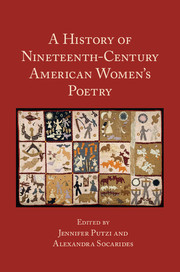Book contents
- Frontmatter
- Contents
- List of Illustrations
- List of Contributors
- Acknowledgments
- Introduction: Making History: Thinking about Nineteenth-Century American Women's Poetry
- PART I 1800–1840, AMERICAN POESIS AND THE NATIONAL IMAGINARY
- PART II 1840–1865, UNIONS AND DISUNIONS
- 8 Women, Transcendentalism, and The Dial: Poetry and Poetics
- 9 Poets of the Loom, Spinners of Verse: Working-Class Women's Poetry and The Lowell Offering
- 10 Women's Transatlantic Poetic Network
- 11 Making and Unmaking a Canon: American Women's Poetry and the Nineteenth-Century Anthology
- 12 “What witty sally”: Phoebe Cary's Poetics of Parody
- 13 Nineteenth-Century American Women's Poetry of Slavery and Abolition
- 14 Fever-Dreams: Antebellum Southern Women Poets and the Gothic
- 15 The Civil War Language of Flowers
- 16 Poetry and Bohemianism
- PART III 1865–1900, EXPERIMENT AND EXPANSION
- Suggested Further Reading
- Index
10 - Women's Transatlantic Poetic Network
from PART II - 1840–1865, UNIONS AND DISUNIONS
Published online by Cambridge University Press: 21 January 2017
- Frontmatter
- Contents
- List of Illustrations
- List of Contributors
- Acknowledgments
- Introduction: Making History: Thinking about Nineteenth-Century American Women's Poetry
- PART I 1800–1840, AMERICAN POESIS AND THE NATIONAL IMAGINARY
- PART II 1840–1865, UNIONS AND DISUNIONS
- 8 Women, Transcendentalism, and The Dial: Poetry and Poetics
- 9 Poets of the Loom, Spinners of Verse: Working-Class Women's Poetry and The Lowell Offering
- 10 Women's Transatlantic Poetic Network
- 11 Making and Unmaking a Canon: American Women's Poetry and the Nineteenth-Century Anthology
- 12 “What witty sally”: Phoebe Cary's Poetics of Parody
- 13 Nineteenth-Century American Women's Poetry of Slavery and Abolition
- 14 Fever-Dreams: Antebellum Southern Women Poets and the Gothic
- 15 The Civil War Language of Flowers
- 16 Poetry and Bohemianism
- PART III 1865–1900, EXPERIMENT AND EXPANSION
- Suggested Further Reading
- Index
Summary
Although still an emergent field, transatlantic scholarship has challenged the legitimacy of nation-based literary paradigms and shown that in nineteenth-century Anglo-American culture “the nation and the transatlantic are deeply implicated in one another.” Scholars have demonstrated that the often-stated concern of nineteenth-century American writers with the establishment of a distinctive national literature coexisted with a desire to create relations – whether competitive, hostile, ambivalent, deferential, or imitative – with their British literary heritage; and that British writers discovered in America an alternative political, social, and cultural arrangement that inspired, intrigued, horrified, or unsettled them. Evidence also exists that nineteenth-century American women writers, artists, reformers, and travelers forged professional, personal, and literary relationships with their British counterparts, with whom they shared social and moral goals as well as political and religious concerns. Whether they travelled to Europe or not, American women writers generated and sustained strong connections with this continent and its female inhabitants, and regarded themselves as part of a female-centered transatlantic “web” or “matrix” involving the circulation of ideas and texts and the creation of affective bonds.
The question of how the poetic – and women's poetry in particular – functioned within this transatlantic world has yet to be fully addressed. One of the most provocative facts to have emerged is that an American, Edmund Clarence Stedman, first coined the term “Victorian poetry” and that his book Victorian Poets (1875) defined, theorized, and invented this field of study. Stedman's period-based, critical investigation of the nature of British poetry allowed him to conceptualize the distinguishing features of his own nation's poetry in his follow-up book, Poets of America (1885). In other words, Stedman recognized that a transatlantic framework was “fundamental to the articulation of national poetic traditions not because American poets borrowed from the British, but because comparable historical-material conditions in the two countries produced similar poetries.” Recent discoveries about the “presence of American poetics within Victorian poetics, and of Victorian poetics within American poetics” have also revealed the “centrality of women poets, women's poetry, and figures of women” within the nineteenth-century “traffic in poems” between the two countries.
- Type
- Chapter
- Information
- A History of Nineteenth-Century American Women's Poetry , pp. 170 - 185Publisher: Cambridge University PressPrint publication year: 2016



